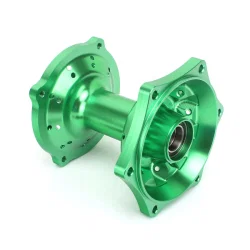How to Identify and Replace a Damaged Front Wheel Hub
2024-09-29
The front wheel hub is a crucial component that connects your wheels to your vehicle’s steering and braking systems. Over time, like any mechanical part, it can wear out or become damaged, especially if you frequently drive on rough roads or put extra stress on your vehicle. Knowing the symptoms of a failing hub and how to replace it can save you time and money on repairs.
Symptoms of a Faulty Front Wheel Hub
Recognizing the early signs of a damaged front wheel hub is key to preventing further issues. Here are the most common symptoms:
1. Grinding Noise: One of the first signs is a grinding or growling noise coming from the wheels when driving. This sound typically gets louder as you accelerate and indicates that the bearings within the hub are failing.
2. Loose Steering: If your steering feels less responsive or loose, it may be due to wear in the hub assembly. A damaged hub can affect the alignment, making it harder to steer precisely.
3. Wheel Play: If you can physically move your wheel from side to side when the vehicle is lifted, this could indicate excessive play in the hub, which compromises safety.
4. ABS Warning Light: Many modern front wheel hubs come equipped with sensors for the anti-lock braking system (ABS). If the hub is damaged, it can interfere with these sensors, causing the ABS light to illuminate.
5. Vibration: A faulty hub can also lead to noticeable vibrations, particularly in the steering wheel, as you drive at higher speeds.
How to Replace a Front Wheel Hub
If you’ve noticed any of these symptoms, it’s important to address the issue promptly. Replacing a front wheel hub can be a complex task, but with the right tools and knowledge, it’s manageable for those with some mechanical experience.
#Step-by-Step Replacement Guide:
1. Lift the Vehicle: First, you’ll need to safely lift the front end of the vehicle using a jack and jack stands.
2. Remove the Wheel: Take off the wheel to access the hub assembly.
3. Remove the Brake Components: This will include the brake caliper and rotor. Be sure to secure the caliper to avoid putting stress on the brake line.
4. Detach the Hub: Depending on your vehicle, you may need to remove additional components like the axle nut and the steering knuckle bolts. Carefully remove the hub assembly from the vehicle.
5. Install the New Hub: Position the new hub assembly in place and reattach all components in reverse order. Be sure to torque all bolts to the manufacturer’s specifications.
6. Reinstall the Wheel: Once everything is secure, reinstall the wheel and lower the vehicle.
7. Test Drive: After completing the replacement, take your vehicle for a test drive to ensure everything is working correctly.
When to Seek Professional Help
While replacing a front wheel hub is possible for DIY mechanics, it’s a detailed process that requires specialized tools and knowledge. If you’re not confident in your ability to replace the hub, it’s best to consult a professional mechanic. Proper installation is essential for your safety and vehicle performance.
Conclusion
A faulty front wheel hub can significantly impact your vehicle's performance and safety. By recognizing the symptoms early and either replacing the hub yourself or getting professional help, you can avoid further damage to your vehicle. Regular inspections of your front wheel hub and related components will also ensure a smoother, safer ride for the long term.



